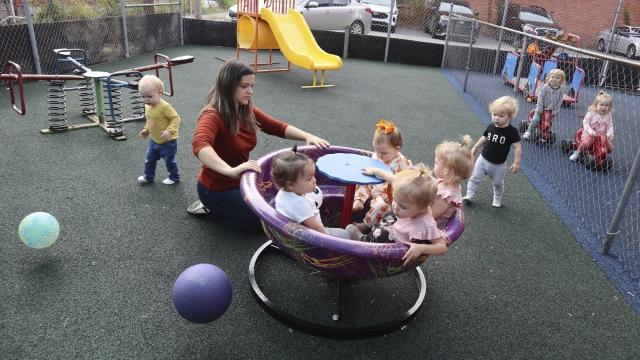A month ago, stabilization funds from the American Rescue Plan officially ended. The money went to states for child care.
So, what's the answer for the millions of families currently looking for help?
We looked at two states: Georgia, and New Mexico. Both have a child care crisis, but they have very different ways of approaching a solution.
Midtown Atlanta is known for high-rises and high rents, companies and condos — it's less known for child care. Yet child care is where Starla Bailey chooses to invest.
"You can go one block south and it's still subsidized housing where our families are walking and pushing strollers and bringing little ones to school," Bailey said.
Investment is all over Bailey's Premier Academy, from the children whose parents haven't had to pay tuition, to the teachers who received raises with pandemic relief money.
That money — $1.2 million for the past two years — has now ended.
"We were able to keep our doors open, and the only way we were able to do that was through the funding that we received," Bailey said, "How do we continue to have a path forward? I don't know."
While many states have authorized new investments in child care, Georgia hasn't. But Bailey isn't just a business owner, she has also been an advocate.
SEE MORE: Seattle day care owners say they need bulletproof windows
Capitol Hill was the source of the pandemic relief funding that's now stopped. But it's also where child care has gained renewed bipartisan attention. The past two years have brought two new Congressional caucuses featuring members of both parties, all while national polling shows voters from both parties believe federal funding for child care should go up.
Mindy Binderman runs the Georgia Early Education Alliance for Ready Students. She meets regularly with Georgia's Congressional delegates and says she'll be ready to move once a federal bill emerges.
"Families were already struggling, and frankly, child care providers were struggling to keep the doors open," Binderman said.
Swati Keshri is both a parent and teacher at the Premier Academy. She's also an example of relief dollars making a difference. Once a doctor in India, she came with her family to Atlanta. Through Premier, she found a job, steady training and care for her son, Reyansh.
Bailey says she's saved enough money to keep the ship steady through the year, and maybe into next year too. In the meantime, she's seeking solutions. She wants to coordinate with fellow child care centers and private businesses on partnerships. And she's willing to wade back into advocacy, wherever that leads.
As Georgia residents await help from the federal government, it's a different story in the state of New Mexico.
Merline Gallegos keeps opening her doors, keeps teaching kids colors and keeps caring for children in her Las Cruces home.
"I start at six in the morning, through six in the evening," Gallegos said.
She keeps working — one month after a deadline that shook child care centers across the country. Nothing has changed, yet.
"Now we are coming back into this cycle of, well, shall I keep on working? Should I shut down? How can I secure the funding to continue paying our staff — because we need help," Gallegos said.
SEE MORE: Federal child care funding from American Rescue Plan Act ending
Gallegos says federal funds helped keep her business alive. But it's still alive because she happens to live in a state that has become a national model of action on child care.
Maty Miranda is a community organizer with the group OLE. Before the pandemic, New Mexico consistently ranked among the worst states in America for child care. More than a quarter of teachers made below the poverty level. Access was slim in a scenic but spread-out state. Then came the COVID pandemic.
That's when an emergency situation met a receptive state government and a rising tide of advocates — including Gallegos.
In 2021 the state expanded child care subsidies and waived copays for families up to 400% of the poverty level – basically, anyone making less than $120,000 a year. In 2022, 70% of residents voted for an amendment to add roughly $140 million a year for early childhood programs. As a result, in 2023, at a time when centers have been shutting down, New Mexico has thousands more open spaces for child care and thousands more children receiving aid than before the pandemic.
"Families, once they receive the support, will no longer be asking for help. And what the families want to do is they want to work independently, but they want to contribute to the state," Miranda said.
It's why Gallegos' group includes a sixteen-month-old named Santiago.
His mom, Maria, is grateful, "There's a lot of us parents that we either have to choose between going to work, staying at home, or going to work to be able to pay the co-pays of child care."
New Mexico is a leader, but they're not alone. Nearly 20 states made major financial commitments to child care during this year's legislative sessions, from millions to in one case billions of dollars. But in no state does the money committed offset the pandemic money that's now gone.
At the home of Gallegos, nothing has changed, at least for her parents and for her small staff. For her, the child care cliff has brought one big change.
"Since the beginning of September, I am not receiving payment. I was thinking of closing and getting a job, but no. I see the children, and I made a commitment here," Gallegos said.
She keeps working, for now for free, and keeps serving her community with the mindset that the secret ingredient is always love.
"I cannot throw in the towel at this time, when we have already achieved great things," Gallegos said.
Trending stories at Scrippsnews.com




